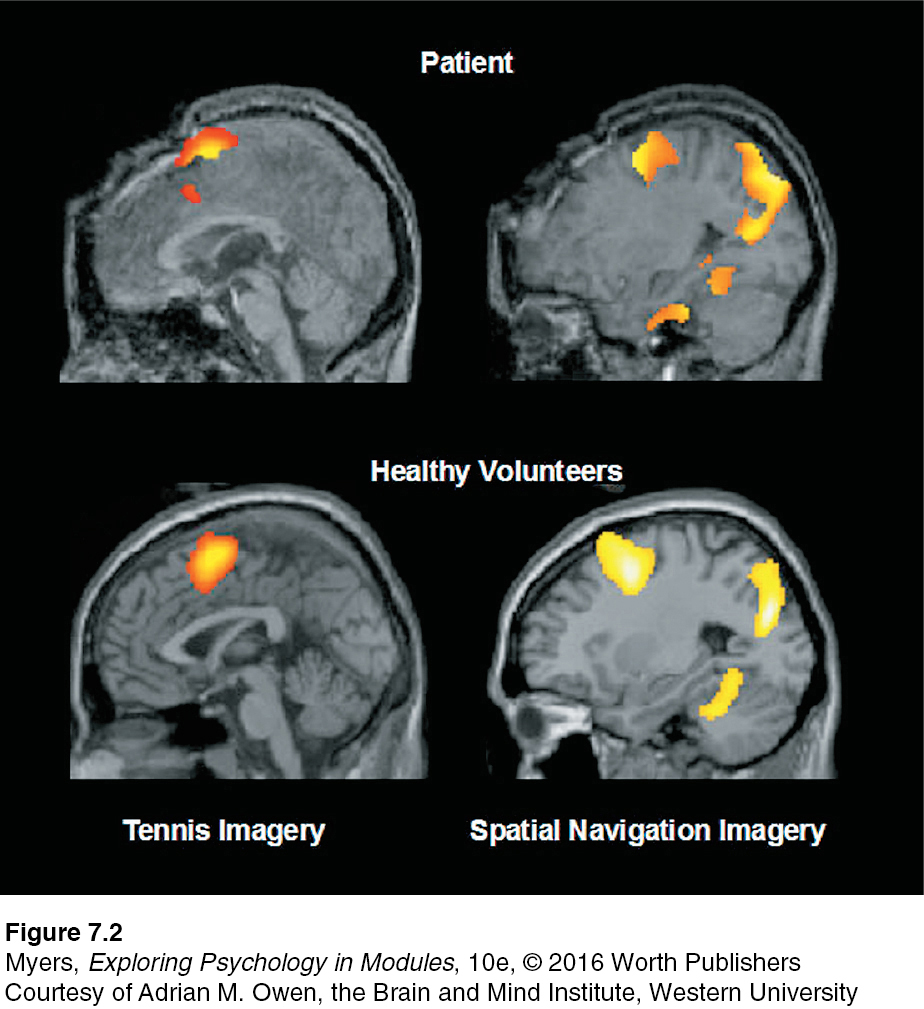7.2 Studying Consciousness
Today’s science explores the biology of consciousness. Scientists now assume, in the words of neuroscientist Marvin Minsky (1986, p. 287), that “the mind is what the brain does.”
cognitive neuroscience the interdisciplinary study of the brain activity linked with cognition (including perception, thinking, memory, and language).

Figure 3.1: FIGURE 7.2 Evidence of awareness? When asked to imagine playing tennis or navigating her home, a noncommunicative patient’s brain (top) exhibited activity similar to a healthy person’s brain (bottom). Researchers wonder if such fMRI scans might enable a “conversation” with some unresponsive patients, by instructing them, for example, to answer yes to a question by imagining playing tennis (top and bottom left), and no by imagining walking around their home (top and bottom right).
Courtesy of Adrian M. Owen, the Brain and Mind Institute, Western University
Evolutionary psychologists presume that consciousness offers a reproductive advantage (Barash, 2006; Murdik et al., 2011). By considering consequences and reading others’ intentions, consciousness helps us to cope with novel situations and act in our long-term interests. Even so, that leaves us with what researchers call the “hard problem”: How do brain cells jabbering to one another create our awareness of the taste of a taco, the idea of infinity, the feeling of fright? The question of how consciousness arises from the material brain is one of life’s deepest mysteries. Such questions are at the heart of cognitive neuroscience—the interdisciplinary study of the brain activity linked with our mental processes.
A stunning demonstration of consciousness appeared in brain scans of a noncommunicative patient—a 23-year-old woman who had been in a car accident and showed no outward signs of conscious awareness (Owen, 2014; Owen et al., 2006). When researchers asked her to imagine playing tennis, fMRI scans revealed activity in a brain area that normally controls arm and leg movements (FIGURE 7.2). Even in a motionless body, the researchers concluded, the brain—and the mind—may still be active. A follow-up analysis of 42 behaviorally unresponsive patients revealed 13 more who also showed meaningful, though diminished, brain responses to questions (Stender et al., 2014).
Some neuroscientists believe that conscious experience arises from synchronized activity across the brain (Gaillard et al., 2009; Koch & Greenfield, 2007; Schurger et al., 2010). If a stimulus activates enough brain-wide coordinated neural activity—as strong signals in one brain area trigger activity elsewhere—it crosses a threshold for consciousness. A weaker stimulus—perhaps a word flashed too briefly to consciously perceive—may trigger localized visual cortex activity that quickly fades. A stronger stimulus will engage other brain areas, such as those involved with language, attention, and memory. Such reverberating activity (detected by brain scans) is a telltale sign of conscious awareness (Boly et al., 2011). For example, awareness of your body involves communication between several brain areas (Blanke, 2012; Olivé et al., 2015). How the synchronized activity produces awareness—how matter makes mind—remains a mystery.
RETRIEVE IT
Question
Those working in the interdisciplinary field called KvR2wfoRQOagD5jws3mKZQBpKvQMZi0+c2d2lQ==
study the brain activity associated with the mental processes of perception, thinking, memory, and language.
